JIRA Import Wizard
This utility allows you to import issues from JIRA directly into Microsoft Project. You can order, group and filter the issues when you import them.
When you select "Import" from The Connector toolbar, you will get the start of the Import wizard.
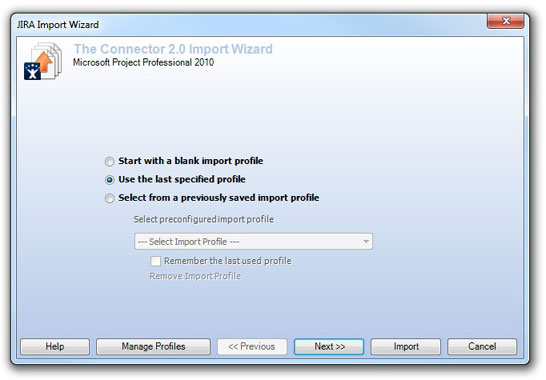
- Start with a blank import profile - This will start with a blank profile that you can configure with the options you wish. Press the "Next >>" button to continue through the wizard.
- Use the last specified values - This allows you to quickly perform an import using the last values that you specified. This is helpful if you constantly import issues using the same settings.
- Select from a previously saved import profile - At the end of the wizard, you are able to name and save the profile for future use. Selecting this option will allow you pick from the list of previously saved profiles.
The second tab of the wizard allows you to pick which project or filters you wish to use for the import. The Connector does allow you to setup a filter within JIRA and import using that filter.
NOTE: The import can either choose multiple projects OR multiple filters but cannot choose a project and a filter.
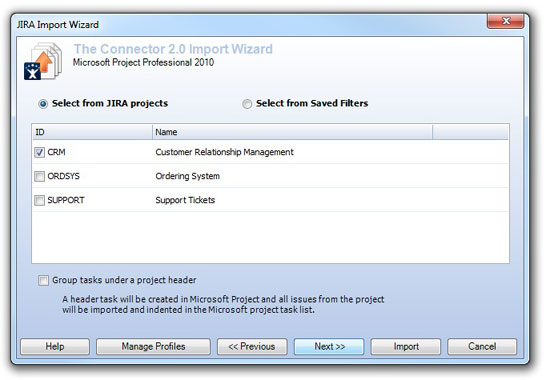
Group tasks under project header - If this option is checked, a header task in Microsoft Project will get created with the name of the project and tasks indented under the project.
When using the "Select from Saved Filters" option, you will get a list of the configured filters in JIRA. You can select a single filter or multiple filters.
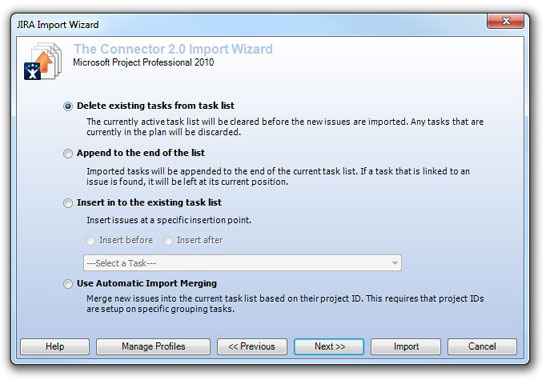
Delete existing tasks from the list - The Connector will clear all the task from your currently open project plan before it begins doing the import.
Append to the end of the list - The Connector will import and append the new tasks to the end of the task list of the currently open project plan. If the task currently exists in the list and matches the issue ID, it will not be added twice. It will be skipped during the import.
Insert in to the existing task list - You can select an existing task from the current tasks in the Microsoft Project project task list. All new issues will be inserted into the plan directly after or directly before the selected task. This is based on the "Insert before" and "Insert after" options that are available.
Use Automatic Import Merging - Merge new issues into the current task list based on their project ID. This required that project IDs are setup on specific grouping tasks.

Exclude subtasks from the import
If this option is chosen, any issue in JIRA that has a type of a sub-task will get excluded from the import. This can be used if you wish to import only the high-level parent tasks into your project plan.
Consolidate subtasks during the import
The consolidate option will also exclude the subtasks from the import, but it will consolidate all of the estimates of the children tasks and roll those up to the parent task.
Indent subtasks during the import
If this option is chosen, subtasks are included in the import and will be imported and indented under their parent task.
Import subtasks on the same level as the part task
Use this option if you wish to import all of the issues in JIRA, including the subtasks, but you don’t care about the issues relationship to its parent. This can be useful if a sorting mode is used that does not allow the task to be indented.
NOTE: Even if this option is chosen, the relationship to its parent task in JIRA is preserved and updates still work correctly.
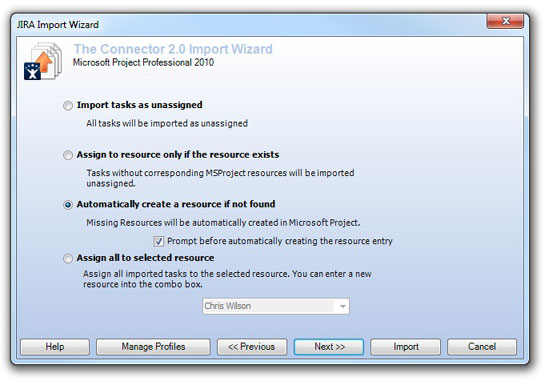
Import tasks as unassigned
When this option is chosen, all of the tasks will get imported as unassigned, regardless of their assignment status in JIRA.
Assign to resource only if the resource exists
This option will assign the resource only if a matching resource can be found in the current resource sheet of the open project. New resources will not get created and you will not be prompted about any resource that is missing.
Automatically create a resource if not found
If this option is chosen, a resource entry in your current resource sheet will be created for each unique resource and the task will be assigned. If you check the optional "prompt before automatically creating the resource entry", you will get the option to skip the assignment if it is missing.
Assign all to selected resource
This option will allow you to assign all of the imported tasks to the same user. Simply pick the user from the available list of users and after the import completes, all of you tasks will be assigned.
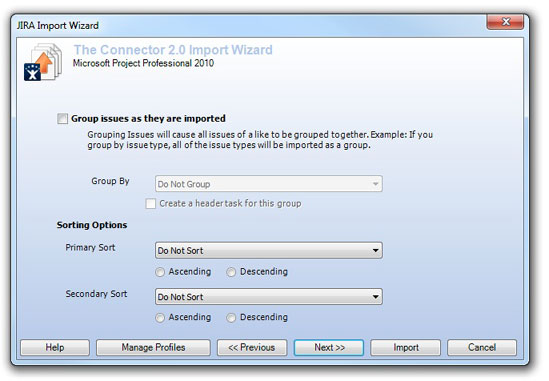
Group issues as they are imported - The Connector allows you to sort and group the issues are they are being imported. You can use the Group By option to select one of the predefined available grouping options.
To sort the issues as they are coming in, you can select both a primary sort and a secondary sort and control whether they are sorted ascending or descending.
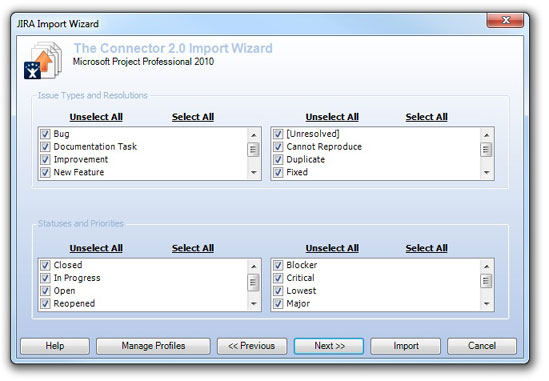
You can filter the import on the issue type, resolution, status, and priority. Simply check the options you wish to have included in the import. You can use the "Unselect All" and "Select All" options for checking all the options available in a specific group.
Versions and Components can also be filtered during the import. Simply select which versions and components you wish to have included in the import. The "Include Unassociated" checkbox will determine if any issue that is not associated with a version or component is included.
You can use the "All" and "None" checkboxes to check all or clear all the selection.
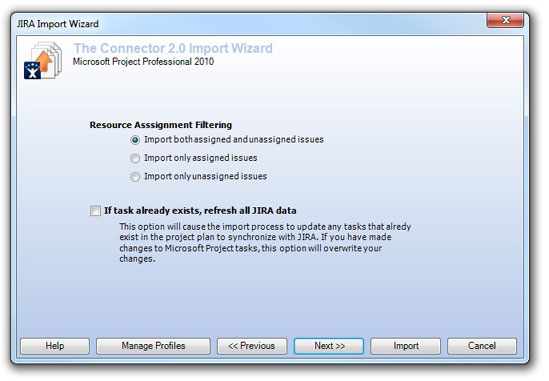
Resource Assignment Filtering
You can use the resource assignment filter to control which types of issues are included. If you chose to only include the unassigned issues, than any issue that has an assignment will be excluded from the import.
If task already exists, refresh all JIRA data
If this option is checked, The Connector will scan the current project sheet for existing tasks and if it finds a match, the import will update that task with the current values from JIRA.
CAUTION: If this option is checked and changes have been made in Microsoft Project, your data will be overwritten.
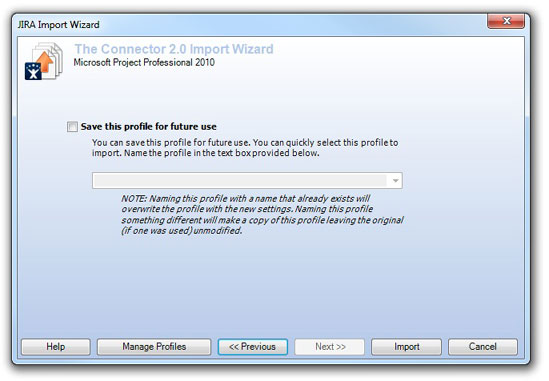
Save this profile for future use
If you wish to save this profile for future use, simply check the save checkbox and name the profile. You can name this profile anything you wish. Once saved, it will show up in the first screen of the import wizard as an available import profile.